Painting, decorating and home improvement tips blog
Making and using a water level
Posted by Adrian
March 31st, 2021
Making and using a water level
Water levels can come in very useful when you need to make a level line across a big expanse, such as in a room and a level simply won’t do. You can buy laser levels but they can be expensive and you may only require it once, this post describes how to make a cheap water level.
Water levels can be used for things such as dado and picture rails, wallpaper borders etc.
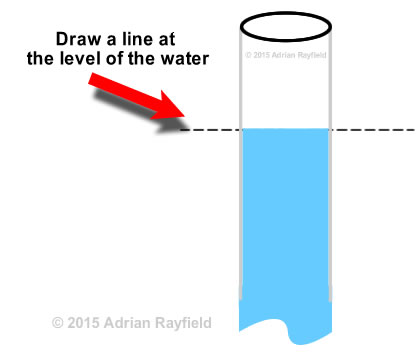
Making a water level
To make a water level is fairly straightforward, you will need the following items.
- A long length of clear tubing
- Water
- Something to bung ends of tube (optional)
- Funnel (optional)
You will need a length of clear tubing, long enough to reach around your work area, such as a room. The tube needs to be clear so you can see the water, so a garden hose wouldn’t be any good as it isn’t transparent.
Once you have your length of tubing you need to fill it with water. This can be done by using a funnel in one end of the tube and running water into it to fill the tube. You can also try the syphon method, but whatever you find works best for you. Make sure that there are no air bubbles in the length of tube, if there are work them out to an open end.
Don’t fill the tube fully as you will need to allow the water to move without it coming out all over the place and for it to settle to get the level.
Once the tube is filled enough you will need to stop the water coming out again, this can be done simply by placing your thumb over the end or a bung of some kind if you have one.
Using a water level
Now that you have made your water level you are ready to use it. You will need a starting point, this can be achieved by measuring and making a pencil mark, or maybe using an existing level, such as a dado rail, it could even be something in another room if the tube is long enough. For example if you want to make sure the dado rail is the same in two rooms. This will be your starting point.
You will need a second person to help you with using the level. One stays at the original level point whilst the other uses the level and marks the wall at the level.
The person holding the ‘fixed’ end, that is the original level mark stays holding the tube at this point, whilst the second person moves to a new point and holds the tube against the wall. The first person instructs the second person to move up or down until the water is level with the original mark, the second person can then mark the wall level with the water in the tube, thus giving a level line.
Continue doing this in several places as required. Remember not to lift tube too high without having end blocked as it will flow out. You can then if required draw a line and join up the marks.
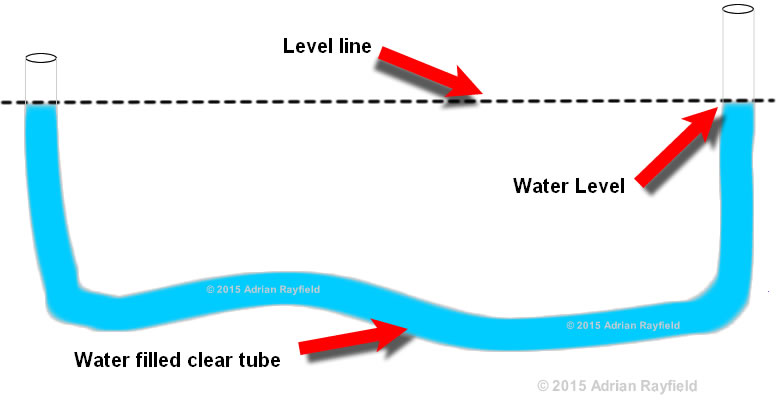
Tags: Dado rail, Decoratomg, DIY, Handyman, Level, Painting, Wallpaper Border, Water, Water Level, Woodwork
Posted in Home Improvements | No Comments »
In an emergency – Knowing your utilities
Posted by Adrian
August 19th, 2019
In an emergency – Knowing your utilities
In an emergency it’s important to know where to find your utilities such as gas, electric and water and know how to turn them off if you need to. It is always good to be prepared and have a plan of action, just in case. Knowing where your utilities are could reduce any further problems or damage to your property.
Water
You should know how to turn off your water supply, to do this you need to know where to find your main stop cock. This may be in the house, your garden, front path or driveway. You may also need a ‘key’ to turn it off as some stop cocks are under a cover, out of your reach, so if you need one of these make sure you know where it is.
Depending on the problem you may be able to isolate the problem locally by turning off an isolator valve, thus leaving the water on to the rest of the house. Isolator valves typically have a slotted screw on them, turn this with a screwdriver a quarter turn, handy to know where you can lay your hands on a screwdriver too. Some valves have a lever, simply turn a quarter of a turn in the direction indicated. Other valves you may have are gate valves, these have a tap looking head on them, turn clockwise to turn of the water.
Labelling which pipe is which and having isolator valves fitted is the best option, turning them off every few months will help keep them in working order and prevent limescale build up that can clog up the valve and make it hard or impossible to shut off.
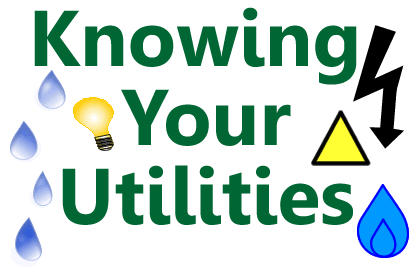
Electricity
If you have an electrical problem and you need to turn off the power, do you know how to turn yours off? If you need to turn the mains power off you need to do so at the fuse box, or consumer unit as it is called. You should see some fuses and a main switch, turn the main switch off. Most commonly your fuse box will be in a downstairs cupboard or under the stairs. It’s always a good idea to keep a torch handy so you can see what you are doing and if your turning the power off at night you need to see where you are going safely.
If you know what the problem is or you just want to turn part of the power off, say the downstairs sockets because you need to work on them, you can turn that fuse off, or for older fuse boxes remove the fuse.
If you have an older style fuse box, keep some fuse wire beside the fuse box in case one blows, you should never replace fuse wire until the problem that caused it is fixed and never use a higher rated fuse wire than is intended.
Gas
At the first sign of a gas leak you should turn off the mains gas supply to the house. This maybe under the stairs, in the garage or outside in locked utility box. You should never turn on any electrical appliance or switch as a spark could cause an explosion, do not smoke or light a match or use any naked flame, such as a candle. Open windows and doors to ventilate the house then call your emergency number of the gas supplier or the National Gas Emergency service on 0800 111 999.
You should stay out of your property until the gas has disbursed, if the leak is bad enough inform you neighbours and advise them they may need to leave their property to be safe. If you have inhaled a lot of gas you may feel ill, you should seek medical advice straight away.
It is a good idea to have a list of emergency numbers so you know where they are in case of an emergency. Maybe have them on a notice or pin board or on your fridge or freezer.Knowing your utilities and how to turn them of in an emergency
Tags: Consumer Unit, Electricity, Emergency, Fuse, Fuse Box, Gas, Isolator Valve, Meter, Stop Cock, Utilities, Valve, Water
Posted in Home Improvements | No Comments »
Saving money on your energy bills
Posted by Adrian
December 21st, 2018
Saving money on your energy bills
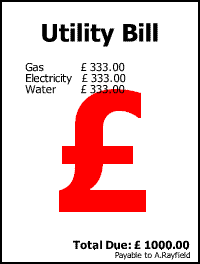
Over the past few weeks the UK has endured some very cold weather including strong winds and several centimetres of snow. The first thing people do when we get this type of weather is turn on the heating and turn it up, but could you be doing things to stop the cold draughts and heat loss from your home?
If you lose heat from your house you are literally burning money, badly fitting doors and windows are often a major contributory factor to heat loss as well as badly insulated walls and loft spaces. So what can be done?
By spending a little bit of time and money you can reduce your electricity, gas or water utility bills. Many things you can do yourself if your are a keen DIYer or Handyman.
Doors and windows
Draughts from around doors and windows not only let cold in but can allow heat to escape, you can fit a self-adhesive rubber or foam seal around the window or door to shut onto to reduce draughts, fitting brush draught excluders on the bottom of a door will reduce the cold from coming under the door. Even fitting a simple key hole cover over a door lock will reduce heat loss.
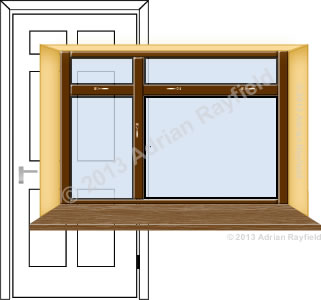
Ideally good fitting double glazed windows is the best option but these can be expensive to have fitted, but if you have single glazed windows you can still do more, such as fitting thick lined curtains and pulling them across mid afternoon as it gets dark and the temperature starts to drop. You could also fit secondary glazing throughout the winter months and remove it during the warmer summer months.
If you have a letterbox on your door consider fitting a draught proof flap on both sides, alternatively you can add a brush letterbox cover inside to reduce draughts and heat loss.
You can also buy, or make a draught excluder for the bottom of the door, these are often ‘sausage dogs’ if you buy them but can easily be made from and old pillow case and filled with old rags, whatever they are made from or the style they can reduce heat loss from the bottom of the door.
Lofts and Loft hatches
Heat rises so ensuring the loft space has enough insulation, current recommendations for mineral wool insulation is 270mm but other types of insulation may need more or less, check with the manufacturer. Also don’t forget flat roofs, they also need to be insulated.
Having a well fitted insulated and draught proofed loft hatch also can not be overlooked, no point in insulating the loft space then not doing the loft hatch. Attach insulation on the inside and fit a rubber seal for the hatch to shut onto, just like any other door.
Pipes and pipework
You can buy pipe lagging very cheaply and is easy to fit, it is often made from foam and can be fitted over the pipes, both hot and cold. You can also buy felt insulation but is harder to fit over installed pipework. If you buy the foam type just ensure you but the correct bore size for the size of copper pipe, normally either 15mm or 22mm.
Often an overlooked area is the outside, if you have pipes going outside, make sure the gaps around them are filled in, this includes plastic pipes such as waste pipes as well as copper pipes. If you have copper pies outside, lag these to stop them from freezing.
Radiators
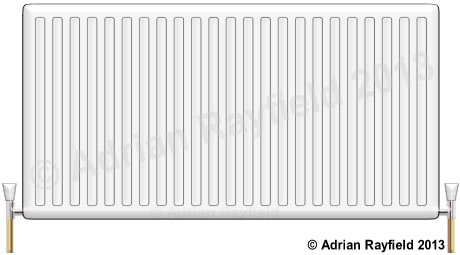
If you have radiators, make sure you bleed the air out of them, to tell if they need doing feel the top, middle and bottom, if the top is colder it is more than likely filled with air and need bleeding. This is a simple job and all you need is a bleed key, then open the bleed valve on the radiator a small amount until water comes out, then do the bleed valve up tight again.
If you have cold areas in your radiator you are not using the radiator efficiently and if you turn the heating up to compensate for the cold area on the radiator you are using more energy to heat the bottom of the radiator, bleed them and turn the heating down a bit.
Hot water tanks
Your hot water cylinder is where you store your hot water, if this isn’t insulated properly and you lose heat from it you will need to keep re-heating the water, so using more energy. The insulation should be at least 75mm thick, if it isn’t you can buy a hot water cylinder jacket to wrap around it.
Walls
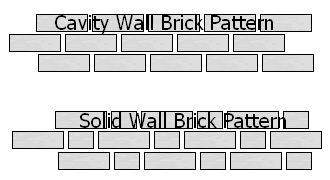
If your walls are not insulated but you have a cavity between the inner and outer walls it is worth insulating them, this will reduce the heat loss from your walls. If you are unsure if you have a cavity in you wall or if you are unsure if your walls have cavity wall insulation, if you can see your bricks, look at the pattern if it is regular you will more than likely have a cavity, if the bricks have alternate, that is if you can see a full length brick, then the end of a brick you may not have a cavity but a solid wall, check with a cavity wall insulation firm in your area.
If your house was built before or up to the 1920’s it is most likely to have solid walls, after this time it should have a cavity and any house built from the 1990’s will most likely have a cavity wall with cavity wall insulation.
As for the inside of the walls, you can line them with a thermal liner, this only really needs to be done on the exterior walls as it is fairly expensive, but can be done on all of the walls. By having a thermal liner it will help even more with the heat loss through your walls.
Solar Panels
If you wish to go a step further, you can install solar panels on your roof to help with your electricity bills, and even reduce your bills by feeding the grid with your unused electricity. Although initially expensive to install it is a long term investment.
Finally
Please remember that houses need to be ventilated to stop mould growth, wet and dry rot and to keep a healthy environment inside the house so please do not block any air bricks, window trickle vents or air vents such as those near a boiler.
With many of the ways to save money on your energy bills mentioned above, you may be able to get Government grants, financial support and even earn money such as if you install solar panels, so have a look around to see what you can get help with.
Tags: Cavity Wall, Door, Draught Excluder, Electric, Electricity, Gas, Insulation, Pipes, Radiators, Solar Panels, Solar Power, Thermal liner, Utility, Ventilation, Water, weather, Window
Posted in Home Improvements | No Comments »
